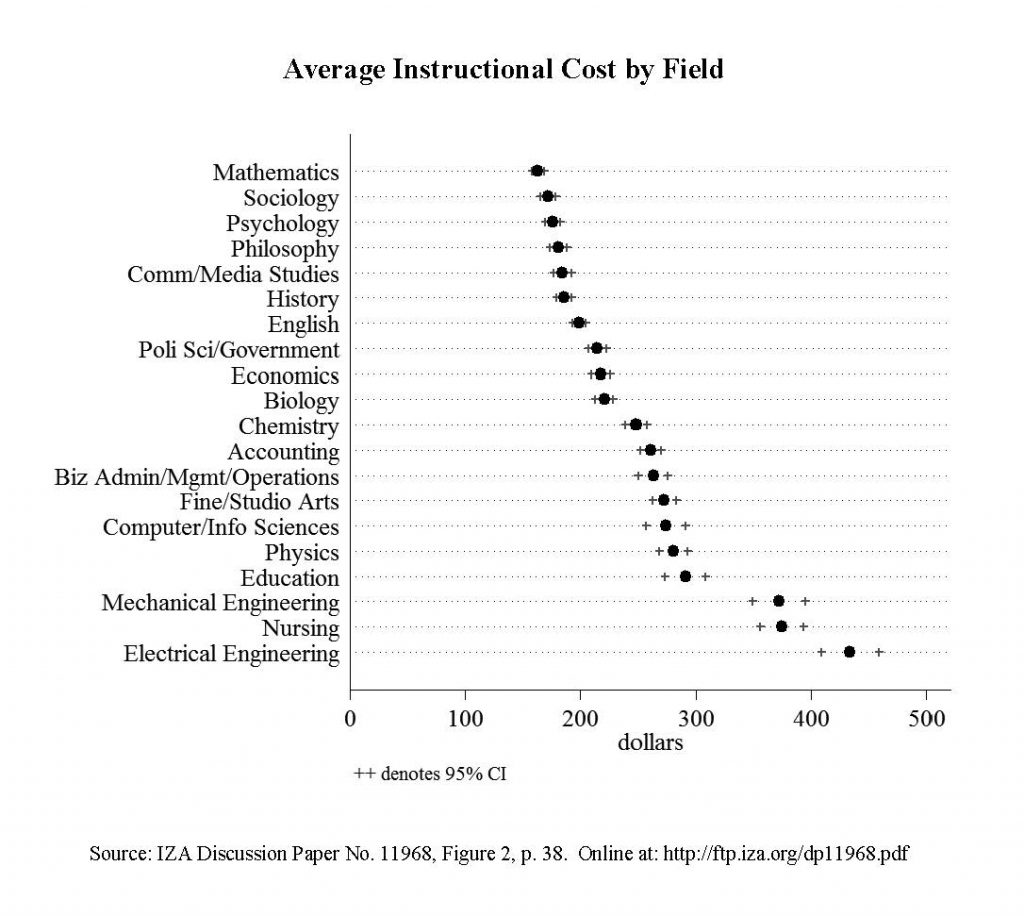As the price of college continues to rise alongside falling state support for public institutions of higher education, students and families bear a growing share of the costs of college. Concerns about the affordability of higher education have led to calls for creative thinking about ways to temper rising costs. However, at the same time, demand for increased training in STEM fields and policies that push students toward such fields abound.
Instruction represents a key category of expenditure at most institutions. Thus, efforts to contain costs must thoughtfully attend to instruction. However, detailed information on instructional costs has been historically difficult to obtain, especially across disciplines. Discipline-specific costs have implications for policies such as differential tuition, budget allocation models, and initiatives that encourage students toward certain fields.
A new IZA discussion paper by Steven Hemelt, Kevin Stange, Fernando Furquim, Andew Simon, and John Sawyer provides the most comprehensive overview of the costs associated with teaching across 20 fields based on a large and diverse sample of four-year colleges and universities from the Delaware Cost Study. The results show that the cost of a unit of instruction differs markedly by discipline.
A student credit hour of electrical engineering, for example, costs twice as much as a credit hour of English. At the other extreme, math is about 22 percent cheaper per credit hour than English. In general, pre-professional fields like business and accounting, along with fields that typically command higher earnings like engineering and nursing, are more costly to teach than the social sciences and humanities.
What explains this variation in costs across fields?
The authors partition differences in instructional costs into four drivers: faculty salaries, faculty workload, class sizes, and non-salary expenses (e.g., lab and equipment costs). Differences in class sizes and faculty salaries tend to explain the bulk of differences in costs across fields. For example, though average salaries are higher for economics faculty than English faculty, class sizes in economics are substantially larger than in English, resulting in costs of instruction per credit hour that are slightly lower in economics than English. Business and accounting faculty also earn more relative to English, but the larger class sizes in these fields only partially offset those differences in pay. Faculty workload and non-personnel expenses generally play minor roles in explaining cost differences across fields.
The paper also shows that marginal costs vary widely across fields and are meaningfully shaped by whether a department offers graduate programs. For example, electrical engineering has the highest marginal cost, in addition to the highest average cost. Documenting differences in relative marginal costs helps to assess possible benefits of initiatives like differential pricing and the cost implications of increasing demand for STEM education.
What can we learn about trends in instructional costs over time?
In contrast to the narrative of soaring prices, inflation-adjusted instructional costs have remained relatively flat over the past decade and a half. However, this average trend obscures variation by field. Costs for many STEM fields like mechanical engineering, chemistry, biology, and nursing declined over the period, as class sizes and faculty teaching loads increased, and as contingent faculty, who are paid less, became more prevalent. Costs increased for many fields in the social sciences and for pre-professional programs, reflecting reductions in class size and higher salaries (most pronounced for accounting, economics, and business faculty).
The adoption of online education has commanded sustained interest from policymakers and institutional leaders as a cost-saving innovation. However, the authors find that the take-up of online education remains relatively low; only about half of programs offer any online instruction. Nursing is the field with the highest rate of online instruction, but even among nursing programs online education accounts for 15% of instruction in undergraduate programs, and 35% at the graduate level. The authors find little evidence that online education lowers average costs of instruction, though results suggest that programs that are substantially online may experience lower costs.

